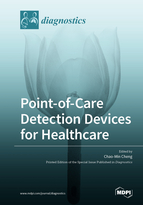Point-of-Care Detection Devices for Healthcare
A special issue of Diagnostics (ISSN 2075-4418). This special issue belongs to the section "Point-of-Care Diagnostics and Devices".
Deadline for manuscript submissions: closed (31 July 2020) | Viewed by 50061
Special Issue Editor
Interests: biomedical engineering; diagnostic methods; vaccines
Special Issues, Collections and Topics in MDPI journals
Special Issue Information
Dear Colleagues,
With recent technological advances in multiple research fields such as materials science, micro-/nano-technology, cellular and molecular biology, bioengineering and the environment, much attention is shifting toward the development of new detection tools that not only address needs for high sensitivity and specificity but fulfil economic, environmental, and rapid point-of-care needs for groups and individuals with constrained resources and, possibly, limited training. Miniaturized fluidics-based platforms that precisely manipulate tiny body fluid volumes can be used for medical, healthcare or even environmental (e.g., heavy metal detection) diagnosis in a rapid and accurate manner. These new detection technologies are potentially applicable to different healthcare or environmental issues, since they are disposable, inexpensive, portable, and easy to use for the detection of human diseases or environmental issues—especially when they are manufactured based on low-cost materials, such as paper. The topics in this Special Issue would cover point-of-care detection devices, microfluidic or paper-based detection devices, new materials for making detection devices, and others (please directly discuss with the Guest Editor).
Dr. Chao-Min Cheng
Guest Editor
Manuscript Submission Information
Manuscripts should be submitted online at www.mdpi.com by registering and logging in to this website. Once you are registered, click here to go to the submission form. Manuscripts can be submitted until the deadline. All submissions that pass pre-check are peer-reviewed. Accepted papers will be published continuously in the journal (as soon as accepted) and will be listed together on the special issue website. Research articles, review articles as well as short communications are invited. For planned papers, a title and short abstract (about 100 words) can be sent to the Editorial Office for announcement on this website.
Submitted manuscripts should not have been published previously, nor be under consideration for publication elsewhere (except conference proceedings papers). All manuscripts are thoroughly refereed through a single-blind peer-review process. A guide for authors and other relevant information for submission of manuscripts is available on the Instructions for Authors page. Diagnostics is an international peer-reviewed open access semimonthly journal published by MDPI.
Please visit the Instructions for Authors page before submitting a manuscript. The Article Processing Charge (APC) for publication in this open access journal is 2600 CHF (Swiss Francs). Submitted papers should be well formatted and use good English. Authors may use MDPI's English editing service prior to publication or during author revisions.
Keywords
- point-of-care diagnostic devices
- paper-based diagnostic devices
- lateral flow immunoassays







